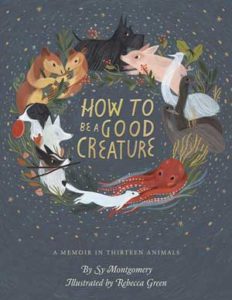How to Be a Good Creature: A Memoir in Thirteen Animals
Reviewed by Pamela Haines
June 1, 2019
 By Sy Montgomery, illustrated by Rebecca Green. Houghton Mifflin Harcourt, 2018. 208 pages. $20/hardcover; $9.99/eBook.
By Sy Montgomery, illustrated by Rebecca Green. Houghton Mifflin Harcourt, 2018. 208 pages. $20/hardcover; $9.99/eBook.
A memoir has the power to invite readers into the life of someone they might never have the opportunity to meet. It can allow us to cross barriers of time, space, and circumstance, and meet people from whom we have been separated by language, culture, religion, class, or race. As we get to know these real people, hear their experiences, their stories, and their truths, we are changed. In How to Be a Good Creature: A Memoir in Thirteen Animals, Sy Montgomery invites us to cross an additional barrier: that of species.
There are powerful stories of crossing the species barrier in this memoir. In the first, as a young emerging field scientist, the author happens totally accidentally across three juvenile emus in their native habitat. Circumstances allow her to see them again, and she starts seeking them out. She takes pains not to alarm them, and gradually they allow her ever closer. She has been taking field notes, but comes to realize that this is much deeper than data; she just wants the chance to be with these amazing creatures.
Years later, at a nature center in French Guiana, a spider expert shares a tarantula he has found living in one of the planters. As the furry creature, the size of a child’s fist, walks across her hands, she is struck by the realization that this is a fellow animal, that they are kin. In that moment, her attitude toward spiders shifts forever.
Then back home, she finds a beloved hen dead, with her head in the grip of a tiny ermine. Something allows her to see the ermine with total clarity:
With dazzlingly white fur, a hammering pulse, and a bottomless appetite, the ermine was ablaze with life. Like a struck match chases away darkness, this creature’s incandescent presence left no room for anger in my heart—for it had been stretched wide with awe, and flooded with the balm of forgiveness.
Short and easy to read, much of this memoir stays close to home, centering around a series of beloved dogs who have been part of the author’s life. There are few surprises here. With dogs sharing 90 percent of DNA with humans and bred to be in relationship with us, this is well-traveled territory where we’ve come to expect such opportunities for deep connection.
The final chapter, in which the author is getting to know an octopus in an aquarium tank, sets up our expectations for something different. She describes the creature’s curiosity, and the feel of all those suction cups exploring her hands and arms. She documents with tenderness this mother’s final days tending to hundreds of eggs that, never having been fertilized, would never hatch. Yet I felt like a voyeur to a sad and constricted shadow of a life. It seemed that a real relationship would have to be on octopus turf where the creature could do her own thing, including tending eggs that were fertile, and might or might not be interested in a human being.
But the book certainly got me thinking about what it means to be a good creature among many. There is much we can learn here from our encounters with other humans. As we reflect on times we have found a bond of commonality across differences that had seemed unbridgeable, we can imagine even more, beyond the confines of our species. We can also learn from all the mistakes humans make with other humans: our unaware assumptions about what’s “normal” and all the ways of casting others in the role of lesser beings, from captivity, anthropological study, and voyeurism to seeing them only in their relationship to us.
I agree with the author that, even with all the curiosity, intellect, and data in the world, we can’t truly know others without loving them. If we haven’t had personal opportunities to know another, we can still stand on the bedrock of open-heartedness and respect. After all, every species plays a valuable role in our common ecosystem. We’re all connected to each other through that system and those connections are real, regardless of how we experience them. We can open our hearts to the wonder of the tarantula, the emu, the ermine, the octopus, and know that our lives will be immeasurably enriched in the process. Yet they don’t need to love us back for that to be true, and we don’t need to wait to love others before offering our complete respect.
Sy Montgomery speaks of how reaching out in this way has shown her that “our world, and the worlds around and within it, is aflame with shades of brilliance we cannot fathom—and is far more vibrant, far more holy, than we could ever imagine.” How to Be a Good Creature is a modest and accessible conversation starter in this space, cracking open a door to greater possibilities.
1 thought on “How to Be a Good Creature: A Memoir in Thirteen Animals”
Leave a Reply
Comments on Friendsjournal.org may be used in the Forum of the print magazine and may be edited for length and clarity.



Thank you for the review of “How to Be a Good Creature.” Just reading the review brings to mind many F/friends who will join me to give thanks for this delightful and heart-full book.
Judy G.